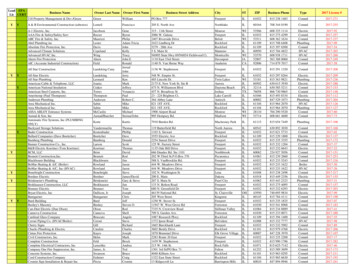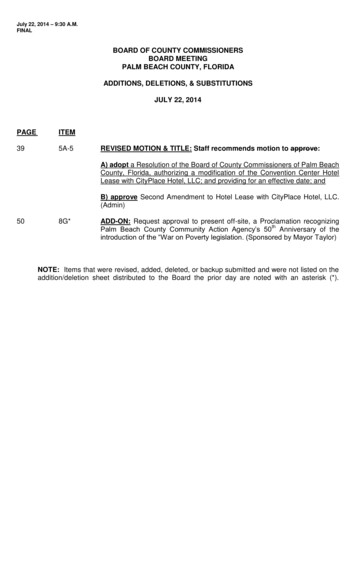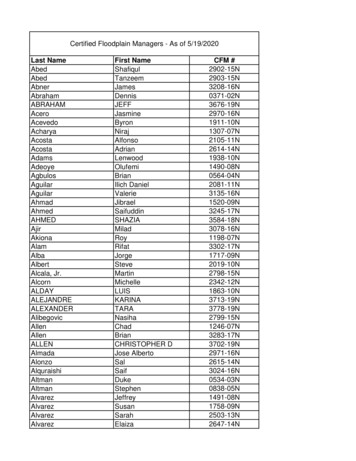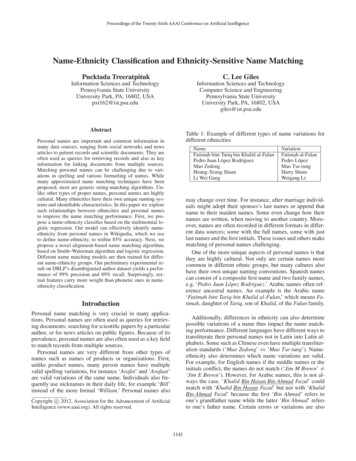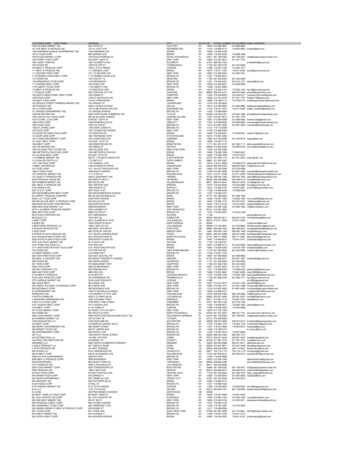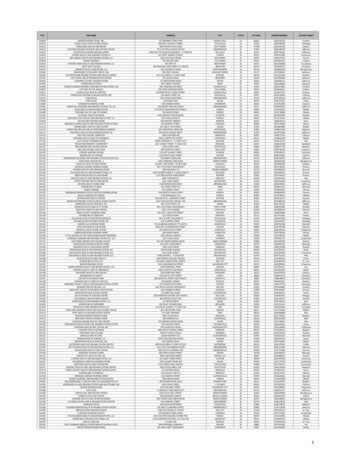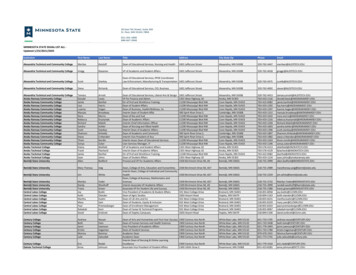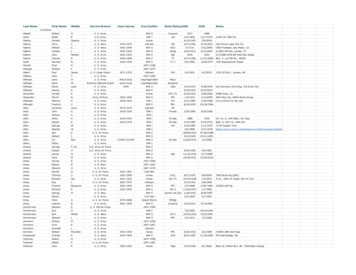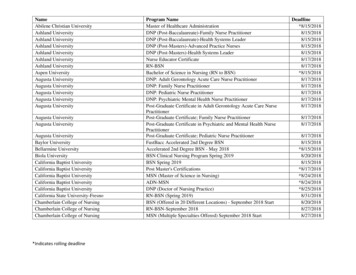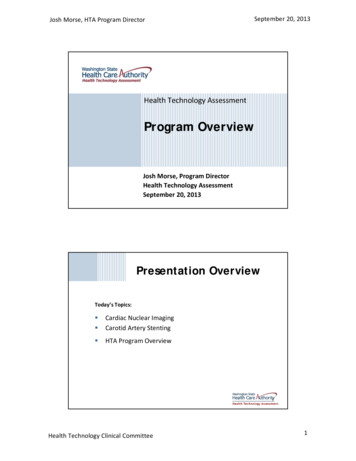
Transcription
Josh Morse, HTA Program DirectorSeptember 20, 2013Health Technology AssessmentProgram OverviewJosh Morse, Program DirectorHealth Technology AssessmentSeptember 20, 2013Presentation OverviewToday’s Topics: Cardiac Nuclear ImagingCarotid Artery Stenting HTA Program Overview1Health Technology Clinical Committee1
Josh Morse, HTA Program DirectorSeptember 20, 2013HTA Background The Health Technology Assessment Program (HTA) is located withinthe Health Care Authority (HCA) 2006 legislation designed HTA program to use evidence reports anda panel of clinicians to make coverage decisions for certain medicalprocedures and tests based on evidence of:¾ Safety¾ Efficacy/ Effectiveness¾ Cost‐Effectiveness2HTA Background Multiple state agency programs participate to identify topics andimplement policy decisions: Health Care Authority– Uniform Medical Plan– Medicaid Labor and Industries Corrections Implementation: Agencies implement determinations of the HTA programwithin their existing statutory framework.3Health Technology Clinical Committee2
September 20, 2013Josh Morse, HTA Program DirectorPurpose: Pay for What WorksEnsure medical treatments, devices and services paid forwith state health care dollars are safe and proven to work. Provide resources for state agencies purchasing health care Develop scientific, evidence‐based reports on medicaldevices, procedures, and tests. Facilitate an independent clinical committee of health carepractitioners to determine which medical devices, procedures,or tests meet safety, efficacy, and cost tests.4ObjectivesConsistency:Minimize Bias:Single source ofscientific evidenceEvolving & Flexible:Keeps pace withIndependent decisionsconsidering evidencefrom allTransparency:Published process opento public inputtechnical innovationsBetter HealthCyclic:for WashingtonCitizens: ProvenHealthcareRegularly assess newevidence on reviewedtechnologies5Health Technology Clinical Committee3
September 20, 2013Josh Morse, HTA Program DirectorHTA ProcessHCA Director Selects TechnologyNominate Review Public Input Priori zeSemi‐AnnualVendor Produces Technology Assessment ReportKey Ques ons Work Plan Dra Comments Finalize2 ‐ 8 MonthsClinical Committee Makes Coverage DeterminationReview Report Public HearingMeets QuarterlyAgencies Implement DecisionImplements Within Current ProcessKey Questions Is it safe? Is it effective? Does it provide value (i.e. improve health outcomes)?7Health Technology Clinical Committee4
Josh Morse, HTA Program DirectorSeptember 20, 2013HTA ValuesTransparency: Publish topics, criteria, reports, conductopen meetingsBest Evidence: Formal, systematic process for review ofselected health care technologies.Independent Decisions: Committee of practicing clinicians makedecisions that are scientifically based, transparent,and consistent across state health care purchasingagencies.8HTCC Decision BasisClinical Committee decisions must give greatest weightto most valid and reliable evidence. Objective Factors for evidence consideration Nature and source of evidence Empirical characteristics of the studies or trials upon which evidence isbased Consistency of outcomes with comparable studies Additional evaluation factors Recency (date of information) Relevance (applicability of information to the key questions presentedor participating agency programs and clients) Bias (conflict of interest or political considerations)Health Technology Clinical Committee5
September 20, 2013Josh Morse, HTA Program DirectorTechnology Topics 2013 Carotid Artery StentingCardiac Nuclear Imaging Hyaluronic Acid/Viscosupplementation (Update) Hip Resurfacing (Update) Facet Neurotomy Non‐Pharmacological Treatments for Treatment‐ResistantDrepression Proton Bean Therapy10How To Participate Visit the HTA Web site: www.hta.wa.gov Join the HTA stakeholder distribution list: shtap@hta.hca.wa.govStakeholders notified of all program publications and meetings Comment on: Proposed topicsKey questionsDraft & final reportsDraft decisions Attend HTCC public meetingsAll meeting materials posted on the web Present comments at Clinical Committee meetings Nominate health technologies for review11Health Technology Clinical Committee6
September 20, 2013Josh Morse, HTA Program DirectorHTA Contact InformationEmail: shtap@hca.wa.govWebsite: hta.hca.wa.gov/Josh Morse, MPH, Program Director(360) 725‐0839Josh.Morse@HCA.WA.GOVThank you!12Health Technology Clinical Committee7
Health Technology Clinical CommitteeDate: May 17, 2013Time: 8:00 am – 5:00 pmLocation: SeaTac Airport Conference CenterAdopted:Meeting materials and transcript are available on the HTA website at:http://hta.hca.wa.gov/past materials.htmlHTCC MINUTESMembers Present: C. Craig Blackmore MD, MPH; Marie-Annette Brown PhD, RN; Joann Elmore, MD MPH;Carson E. Odegard DC, MPH; Richard C. Phillips MD, MS, MPH; Seth Schwartz MD, MPH; Michael Souter MB, ChB, DA, Christopher Standaert, MD; Kevin Walsh MDMembers Absent: David McCulloch, MD; Michelle Simon PhD, NDHTCC FORMAL ACTION1. Call to Order: Dr. Blackmore, Chair, called the meeting to order. Sufficient members were present toconstitute a quorum.2. March 22, 2012, Meeting Minutes: Chair referred members to the draft minutes; motion to approve andsecond, and adopted by the committee.Action: Nine committee members approved the March 22, 2012 meeting minutes. Two members wereabsent.3. Hyperbaric Oxygen Treatment for Tissue Damage Including Wound Care and Treatment of CentralNervous System Conditions Draft Findings & Decision: Chair referred members to the draft findings anddecision and called for further discussion or objection.3. Hyperbaric Oxygen Treatment for Tissue Damage Including Wound Care and Treatment of CentralNervous System Conditions Draft Findings & Decision was approved and adopted by the committee.Action: Nine committee members approved the Hyperbaric Oxygen Treatment for Tissue DamageIncluding Wound Care and Treatment of Central Nervous System Conditions Draft Findings & Decisiondocument. Two members were absent.4. Cervical Spinal Fusion Draft Findings & Decision: Chair referred members to the draft findings and decisionand called for further discussion or objection.Cervical Spinal Fusion Draft Findings & Decision was approved and adopted by the committee.Action: Nine committee members approved the Cervical Spinal Fusion Findings & Decision document.Two members were absent. Cochlear Implants: Bilateral versus UnilateralDraftP.O. Box 42712 Olympia, WA 98504-2712 hta.hca.wa.gov (360) 725-5126 (360) 586-3545 (FAX) TTY 711Page 1 of 4
Health Technology AssessmentScheduled and Open Public Comments:The Chair called for public comments. Four individuals had scheduled time for public comments: Douglas Backous, MD, Swedish Medical CenterStacy Watson, MS, CCC-A, Swedish Medical GroupJohn K Niparko, MD Chair, American Cochlear Implant Alliance, Tiber Albert Professor Chair,Otolaryngology-Head & Neck Surgery, University of Southern CaliforniaKathy Sie, MD, Seattle Children’s HospitalPresentation materials and conflict of interest forms are available with May 17 meeting materials.No open public comments were presented.Agency Utilization and Outcomes:Kerilyn Nobuhara MD, MHA, Senior Medical Consultant, Health Care Authority, presented the stateagency utilization rates for Cochlear Implants: Bilateral versus Unilateral to the committee. The fullpresentation is published with May 17 meeting materials.Vendor Report and HTCC Q & A:The Chair introduced the clinical expert, Jay Rubinstein, MD, PhD, Virginia Merrill Bloedel Professor andDirector, Virginia Merrill Bloedel Hearing Research Center, University of WashingtonTeresa Rogstad, MPH of Hayes, Inc, presented the evidence review addressing Cochlear Implants. Thefull presentation is published with May 17 meeting materials.Committee Discussion and Decision:The HTCC reviewed and considered the Cochlear Implants technology assessment report andinformation provided by the state agencies. They also heard comments from the evidence reviewer, theclinical expert, the public, and agency medical directors. The committee considered all the evidence andgave greatest weight to the evidence it determined, based on objective factors, to be the most valid andreliable.HTCC Committee Coverage Determination VoteCochlear Implants: Bilateral versus UnilateralNotCoveredCoveredUnconditionallyCovered UnderCertain Conditions009 Discussion: The Chair called for discussion of conditions of coverage for Cochlear Implants followingthe majority voting for coverage under certain conditions. The following conditions were discussedand approved by a majority of the clinical committee: Limitations of Coverage:Bilateral Cochlear Implants are a covered benefit for patients:o Twelve months or older;o With bilateral, severe to profound sensorineural hearing loss;o Limited or no benefit from hearing aids;DraftPage 2 of 4
Health Technology AssessmentooooCognitive ability and willingness to participate in an extensive auditory rehabilitationprogramFreedom from middle ear infection, an accessible cochlear lumen that is structurally suitedto implantation, and freedom from lesions in the auditory nerve and acoustic areas of thecentral nervous system;No other contraindications for surgery;Device used in accordance with the FDA approved labeling.Non-covered Indications: None.The committee checked for availability of a Medicare decision. The Centers for Medicare & MedicaidServices (CMS) cover Cochlear Implants for the treatment of bilateral pre- or postlinguistic, sensorineural,moderate-to-profound hearing loss in individuals who demonstrate limited benefit from amplification. Forconditions addressed by the CMS National Coverage Determination and the HTA review, the HTCCdetermination is consistent with the CMS policy.Chair directed HTA staff to prepare a draft coverage determination document for the topic.5. Catheter Ablation Procedures for Supraventricular Tachyarrhythmia (SVTA):Scheduled and Open Public Comments: The Chair called for public comments. Two individualsscheduled time for public comments. Jeanne Poole, MD, Director, Electrophysiology Division of Cardiology, University of WashingtonGerhard H. Muelheims, MD, FACC (Did not appear before the committee.)One individual accompanied Dr Poole and provided open comments: Mohan Viswanathan, MD, University of WashingtonPresentation materials and conflict of interest forms are available with May 17 meeting materials.Agency Utilization and Outcomes:G. Steven Hammond, PhD, MD, MHA, Medical Director, Department of Corrections, presented the stateagency utilization rates for Catheter Ablation Procedures for SVTA to the committee. The fullpresentation is published with May 17 meeting materials.Vendor Report and HTCC Q & A:The Chair introduced the clinical expert, Ramakota Reddy, MD, Electrophysiologist, Oregon Cardiology.Robin Hashimoto, PhD, of Spectrum Research, Inc., presented the evidence review addressing CatheterAblation Procedures for SVTA. The full presentation is published with May 17 meeting materials.Committee Discussion and DecisionThe HTCC reviewed and considered the Catheter Ablation Procedures for SVTA technology assessmentreport and information provided by the state agencies. They also heard comments from the evidencereviewer, the clinical expert, the public, and agency medical directors. The committee considered all theevidence and gave greatest weight to the evidence it determined, based on objective factors, to be themost valid and reliable.DraftPage 3 of 4
Health Technology AssessmentHTCC Committee Coverage Determination VoteCatheter Ablation Procedures for SVTANotCoveredCoveredUnconditionallyCovered UnderCertain Conditions009 Discussion: The Chair called for discussion of conditions of coverage for Catheter AblationProcedures for SVTA following the majority voting for coverage under certain conditions. Thefollowing conditions were discussed and approved by a majority of the clinical committee: Limitations of Coverage:For adults with supraventricular tachyarrhythmias, cardiac catheter ablation procedures(radiofrequency or cryoablation) are covered with conditions: Reentrant tachycardias (e.g. WPW AVRT AVNRT)Atrial flutterSymptomatic atrial flutterAtrial fibrillationSymptomatic atrial fibrillationDrug therapy is either not tolerated or ineffectiveCatheter Ablation Procedures for SVTA is not a covered benefit for other non-reentrantsupraventricular tachycardias.The committee checked for availability of a Medicare coverage decision. CMS does not have anational coverage determination (NCD) for catheter ablation procedures for supraventriculartachyarrhythmia. The committee determined their decision is similar to several evidence-basedguidelines developed by professional Societies and is based on more current evidence.The Chair directed HTA staff to prepare a draft coverage determination document for the topic.The Chair called for further comments. No further comments on review of Catheter AblationProcedures for SVTA.6. Meeting adjourned.DraftPage 4 of 4
Health Technology Clinical CommitteeDraft Findings and DecisionTopic:Meeting Date:Final Adoption:Cochlear Implants: Bilateral versus UnilateralMay 17, 2013Number and Coverage Topic:20130517A – Cochlear Implants: Bilateral versus UnilateralHTCC Coverage Determination:Bilateral Cochlear Implants are a covered benefit with conditions consistent with the criteria identifiedin the reimbursement determination.HTCC Reimbursement Determination:Limitations of Coverage Age 12 months or older;Bilateral severe to profound sensorineural hearing loss;Limited or no benefit from hearing aids;Cognitive ability and willingness to participate in an extensive auditory rehabilitation program;Freedom from middle ear infection, an accessible cochlear lumen that is structurally suited toimplantation, and freedom from lesions in the auditory nerve and acoustic areas of the centralnervous system;No other contraindications for surgery; andDevice used in accordance with the FDA approved labeling.Non-Covered IndicatorsN/AAgency Contact InformationAgencyPhone NumberLabor and IndustriesPublic Employees Health PlanWashington State DraftCochlear Implants: Bilateral versus Unilateral – Findings & DecisionPage 1June 4, 2013
WA – Health Technology AssessmentHTCC Coverage Vote And Formal Action:Committee DecisionBased on the deliberations of key health outcomes, the committee decided that it had the mostcomplete information: a comprehensive and current evidence report, public comments, and agencyand state utilization information. The committee concluded that the current evidence on BilateralCochlear Implants demonstrates that there is sufficient evidence to cover with conditions. Thecommittee considered all the evidence and gave greatest weight to the evidence it determined,based on objective factors, to be the most valid and reliable. Based on these findings, thecommittee voted to cover with conditions Bilateral Cochlear Implants.Cochlear Implants: Bilateral versus Unilateral VoteHTCC Committee Coverage Determination VoteBilateral Cochlear ImplantsNot Covered0CoveredUnconditionally0Covered UnderCertain Conditions9DiscussionThe Chair called for discussion on conditions for use of Bilateral Cochlear Implants due to themajority voting for coverage with conditions. The following conditions were discussed andapproved by a majority:Limitations of CoverageCovered Conditions Age 12 months or older;Bilateral severe to profound sensorineural hearing loss;Limited or no benefit from hearing aids;Cognitive ability and willingness to participate in an extensive auditory rehabilitation program;Freedom from middle ear infection, an accessible cochlear lumen that is structurally suited toimplantation, and freedom from lesions in the auditory nerve and acoustic areas of the centralnervous system;No other contraindications for surgery; andDevice used in accordance with the FDA approved labelingNon-Covered IndicatorsN/AActionThe committee reviewed the evidence report for existing clinical guidelines and Centers forMedicare & Medicaid Services (CMS) decisions. CMS allows coverage of CI for the treatment ofbilateral pre- or postlinguistic, sensorineural, moderate-to-profound hearing loss in individuals whodemonstrate limited benefit from amplification.DraftCochlear Implants: Bilateral versus Unilateral – Findings & DecisionPage 2June 4, 2013
WA – Health Technology AssessmentThe committee Chair directed HTA staff to prepare a Findings and Decision document on BilateralCochlear Implants reflective of the majority vote for final approval at the next public meeting.Health Technology Clinical Committee Authority:Washington State’s legislature believes it is important to use a science-based, clinician-centeredapproach for difficult and important health care benefit decisions. Pursuant to chapter 70.14 RCW, thelegislature has directed the Washington State Health Care Authority (HCA), through its HealthTechnology Assessment (HTA) program, to engage in an evaluation process that gathers and assessesthe quality of the latest medical evidence using a scientific research company and that takes public inputat all stages.Pursuant to RCW 70.14.110 a Health Technology Clinical Committee (HTCC) composed of elevenindependent health care professionals reviews all the information and renders a decision at an openpublic meeting. The Washington State HTCC determines how selected health technologies are coveredby several state agencies (RCW 70.14.080-140). These technologies may include medical or surgicaldevices and procedures, medical equipment, and diagnostic tests. HTCC bases its decisions on evidenceof the technology’s safety, efficacy, and cost effectiveness. Participating state agencies are required tocomply with the decisions of the HTCC. HTCC decisions may be re-reviewed at the determination of theHCA Administrator.Meeting materials and transcript are available on the HTA website at:http://www.hta.hca.wa.gov/past materials.htmlDraftCochlear Implants: Bilateral versus Unilateral – Findings & DecisionPage 3June 4, 2013
Cochlear Implants: Bi versus UnilateralFindings & DecisionTimeline and Overview of CommentsThe Health Technology Assessment (HTA) program received comments in response to theposted Health Technology Clinical Committee (HTCC) draft findings and decision on CochlearImplants: Bi versus Unilateral.CategoryComment PeriodJune 6 – 21, 2013CitedEvidence000000000000Patient, relative, and citizenLegislator and public officialHealth care professionalIndustry & manufacturerProfessional society & advocacy organizationTotalUComments with Evidence:None.Comments without Evidence:None.Technology Assessment TimelineStudy StageDateTechnology recommendations publishedNovember 1, 2011Public comments dueNovember 15, 2011Selected technologies publishedNovember 29, 2011Public comments dueDecember 29, 2011Draft Key Questions publishedNovember 15, 2012Public comments dueNovember 29, 2013Final Key Questions publishedJanuary 10, 2013Draft report publishedMarch 5, 2013Public comments dueApril 5, 2013Final report publishedApril 17, 2013Public meeting dateMay 17, 2013Findings & decision publishedJune 6, 2013Public comments dueJune 21, 2013PublicComment Days1530303116
Health Technology Clinical CommitteeDraft Findings and DecisionTopic:Meeting Date:Final Adoption:Catheter Ablation Procedures for Supraventricular Tachyarryhthmias (SVTA)May 17, 2013Number and Coverage Topic:20130517B – Catheter Ablation Procedures for Supraventricular Tachyarryhthmias (SVTA)HTCC Coverage Determination:Catheter ablation procedures are a covered benefit with conditions consistent with the criteriaidentified in the reimbursement determination.HTCC Reimbursement Determination:Limitations of CoverageFor adults with supraventricular tachyarrhythmias , cardiac catheter ablation procedures(radiofrequency or cryoablation) are covered with conditions: Reentrant tachycardias (e.g. Wolff-Parkinson-White Syndrome (WPW), Atrioventricular reentranttachycardia (AVRT), Atrioventricular nodal reentrant tachycardia (AVNRT)Atrial flutter:o Symptomatic atrial flutterAtrial fibrillation:o Symptomatic atrial fibrillationo Drug therapy is either not tolerated, or ineffective.Non-Covered Indicators Other, non-reentrant supraventricular tachycardiasAgency Contact InformationAgencyPhone NumberLabor and IndustriesPublic Employees Health PlanWashington State DraftCatheter Ablation Procedures for SVTA – Findings & DecisionPage 1June 4, 2013
WA – Health Technology AssessmentHTCC Coverage Vote And Formal Action:Committee DecisionBased on the deliberations of key health outcomes, the committee decided that it had the mostcomplete information: a comprehensive and current evidence report, public comments, and agencyand state utilization information. The committee concluded that the current evidence on catheterablation procedures demonstrates that there is sufficient evidence to cover with conditions. Thecommittee considered all the evidence and gave greatest weight to the evidence it determined,based on objective factors, to be the most valid and reliable. Based on these findings, thecommittee voted to cover with conditions catheter ablation procedures for supraventriculartachyarryhthmias (SVTA).Catheter Ablation Procedures for SVTA Coverage VoteHTCC Committee Coverage Determination VoteCatheter Ablation d UnderCertain Conditions9DiscussionThe Chair called for discussion on conditions for use of catheter ablation procedures forsupraventricular tachyarryhthmias (SVTA) due to the majority voting for coverage with conditions.The following conditions were discussed and approved by a majority:Limitations of CoverageCovered Conditions:For adults with supraventricular tachyarrhythmias , cardiac catheter ablation procedures(radiofrequency or cryoablation) are covered with conditions: Reentrant tachycardias (e.g. Wolff-Parkinson-White Syndrome (WPW), Atrioventricularreentrant tachycardia (AVRT), Atrioventricular nodal reentrant tachycardia (AVNRT)Atrial fluttero Symptomatic atrial flutterAtrial fibrillationo Symptomatic atrial fibrillationo Drug therapy is either not tolerated, or ineffective.Non-Covered Indications:Other non-reentrant supraventricular tachycardiasDraftCatheter Ablation Procedures for SVTA – Findings & DecisionPage 2June 4, 2013
WA – Health Technology AssessmentActionThe committee reviewed the evidence report for existing clinical guidelines and Centers forMedicare & Medicaid Services (CMS) decisions. CMS does not have a national coveragedetermination (NCD) for catheter ablation procedures for supraventricular tachyarryhthmias.The committee Chair directed HTA staff to prepare a Findings and Decision document on catheterablation procedures reflective of the majority vote for final approval at the next public meeting.Health Technology Clinical Committee Authority:Washington State’s legislature believes it is important to use a science-based, clinician-centeredapproach for difficult and important health care benefit decisions. Pursuant to chapter 70.14 RCW, thelegislature has directed the Washington State Health Care Authority (HCA), through its HealthTechnology Assessment (HTA) program, to engage in an evaluation process that gathers and assessesthe quality of the latest medical evidence using a scientific research company and that takes public inputat all stages.Pursuant to RCW 70.14.110 a Health Technology Clinical Committee (HTCC) composed of elevenindependent health care professionals reviews all the information and renders a decision at an openpublic meeting. The Washington State HTCC determines how selected health technologies are coveredby several state agencies (RCW 70.14.080-140). These technologies may include medical or surgicaldevices and procedures, medical equipment, and diagnostic tests. HTCC bases its decisions on evidenceof the technology’s safety, efficacy, and cost effectiveness. Participating state agencies are required tocomply with the decisions of the HTCC. HTCC decisions may be re-reviewed at the determination of theHCA Administrator.Meeting materials and transcript are available on the HTA website at:http://www.hta.hca.wa.gov/past materials.htmlDraftCatheter Ablation Procedures for SVTA – Findings & DecisionPage 3June 4, 2013
Catheter Ablation Procedures for Supraventricular TachyarrhythmiaIncluding Atrial Flutter, Atrial FibrillationFindings & DecisionTimeline and Overview of CommentsThe Health Technology Assessment (HTA) program received comments in response to the posted HealthTechnology Clinical Committee (HTCC) draft findings and decision on Catheter Ablation Procedures forSupraventricular Tachyarrhythmia Including Atrial Flutter, Atrial Fibrillation.Comment PeriodJune 7 – June 21, 2013CitedEvidencePatient, relative, and citizen00Legislator and public official00Physician & health care professional135Industry & manufacturer00Professional society & advocacy organization00135CategoryTotalUComments with Evidence:Physician & Health Care ProfessionalEteri Byazrova, MD, Kootenai Heart Clinics NorthwestPatients with ectopic atrial tachycardias have debilitating symptoms. Medical therapy is ineffective formost of them. Without curative ablation, patients may make more trips to the Emergency Room, beforced to seek disability or develop-tachycardia-induced congestive heart failure.For over 60% of patients, antiarrhythmic drugs are ineffective, not tolerated, or contraindicated due tosafety concerns. Other risks of medications include drug toxicity , proarrhythmia, and sudden death.Atrial fibrillation was traditionally considered a non-life threatening condition. An AFFIRM study of atrialfibrillation patients randomized to two groups, rate control or rhythm control with antiarrhythmicdrugs, showed antiarrhythmic drugs helped maintain sinus rhythm in about 30% of patients. It alsodetermined do difference in mortality rates between the two groups. However, follow-up analysisrevealed a 0.54 hazard ratio for patients in the sinus rhythm group and 1.41 for patients on rhythmcontrol drugs. The beneficial effect of sinus rhythm maintenance drugs was offset by the toxic effects ofthe medications, resulting in no overall mortality difference between the rate control and rhythmcontrol groups.Two prospective studies showed regression of LV dysfunction and congestive heart failure in atrialfibrillation patients, and the benefit was present in patients with appropriate rate contral at baselaine.Draft Findings & Decision: Timeline and Overview of CommentsPage 1 of 5
WA – Health Technology AssessmentSeptember 20, 2013One randomized trial demonstrated superiority of catheter ablation t biventricular pacing/ ablation ofthe AV node in patients with congestive heart failure and atrial fibrillation. At least one study hasaddressed the issue of cost. Catheter ablation as a first first-line therapy was compared toantiarrhythmic drug trail as first line, and at two years, cumulative cost was the same in both groups.Harold Goldberg, MD, FACC, Providence Spokane Heart Institute, Spokane CardiologyThe Committee should not restrict procedures that have well-demonstrated clinical benefit. Atrialtachycardia represents 5% or less of episodes of rapid heart rhythms. In addition to symptoms of rapidbeating, patients can occasionally have episodes of tachycardic-dependent cardiomyopathy – weakheart muscle as a result of heart racing.A study by Dr. Shih-Ann Chen of China demonstrated efficacy-98% cure of atrial tachycardia. In the studyof 36 patients, 7 out of 36 had automatic atrial tachycardia, 9 out of 36 had triggered atrial tachycardia.Therefore, 20 patients had reentrant tachycardia and in summary 16 had non-reentrant tachycardia. Thestudy demonstrated efficacy in both groups. It would not be appropriate to isolate non-reentranttachycardia patients for non-reimbursement when ablation has been demonstrated to be effective.Harold A Kwasman, MD, FACC, Providence Spokane Heart Institute, Spokane CardiologyNon-reentrant arrhythmias are equally amenable to ablative therapy. This is frequently the onlytreatment to control these arrhythmias, since many are not effectively treated pharmacologically.A non-reentrant arrhythmia reflects atrial myocardial cells that fire automatically. This is usually a verylocalized focal event and with appropriate mapping techniques, electrophysiologists are able to identifythat focus and ablate the rogue cells, rendering the patient free of their arrhythmia.Often times, patients with these ectopic atrial tachycardias develop secondary cardiomyopathy.Controlling this arrhythmia often results in normalization of the patient’s heart function.Jordan Prutkin, MD, MHS, FHR, Division of Cardiology/ Electrophysiology, University of WashingtonAblation for atrial tachycardia is considered standard of care for patients who have failed antiarrhythmicdrug therapy. Guidelines from the US and European cardiology societies say that catheter ablation forrecurrent, symptomatic, focal atrial tachycardia is a Class I recommendation. It is also a class Irecommendation for asymptomatic or symptomatic incessant atrial tachycardia. Success rate for thisprocedure, according to a pooled analysis, was 86%.Mohan Viswanathan, MD, FACC, Assistant Professor of Medicine, Division of Cardiology/CardiacElectrophysiology, University of Washington School of MedicineAgrees with the document in its overall spirit and identifies one omission – focal atrial tachycardia.When a focal atrial tachycardia is left unchecked, this arrhythmia can degenerate into atrial fibrillation.With catheter ablation for the dominant focal atrial tachycardia, risks of morbidity and mortality arereduced and the pa
Review Report Public Hearing Meets Quarterly . Key questions . Electrophysiology Division of Cardiology, University of Washington Gerhard H. Muelheims, MD, FACC (Did not a
